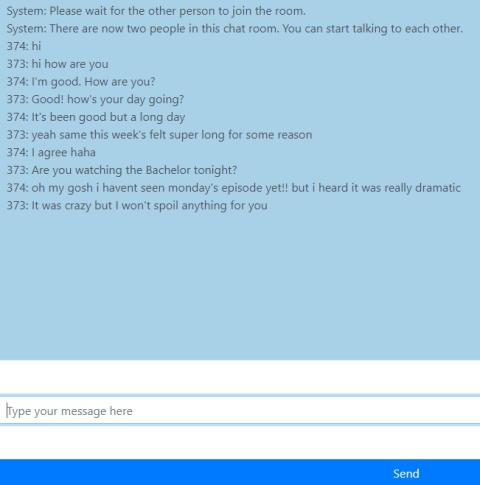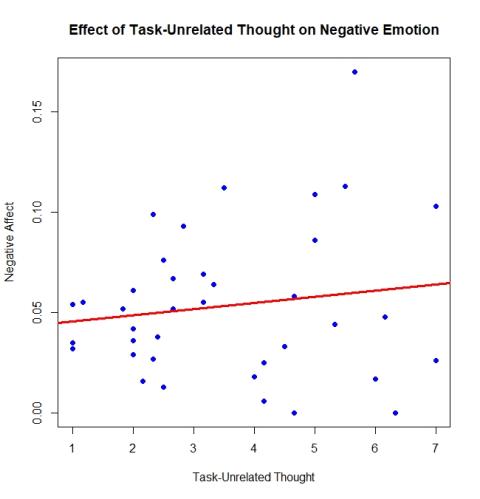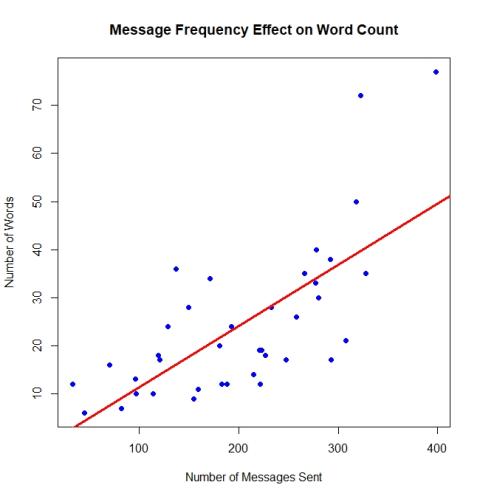Understanding Interpersonal Trust and Task-Unrelated Thought Through Computer-Mediated Health Conversations
Most of our lives, whether professional or personal, consist of building relationships to manifest personal fulfillment through career advancement, inclusion in social groups, or attracting a significant other and raising a family. Building relationships with peers, mentors, and other professionals to achieve these subjective goals is usually facilitated through carefully attending to the way we converse with others, and creating meaningful conversations. In the twenty-first century, many of us rely primarily on text-based technologies, including instant messaging, texting, and email, making the effectiveness of these computer-mediated modes of communication especially vital to building relationships.

Tyler Stetson
Building trust in both personal and professional relationships can be more difficult by text because of a lack of face-to-face social cues and emotion. In many different fields where professional boundaries must be maintained, individuals struggle to effectively construct meaning through instant messaging (IM) or email, making interpersonal trust even harder to establish among coworkers and in other professional settings. This is especially important in healthcare, where an increasing number of hospitals and clinics are transitioning non-urgent patients to telehealth. Healthcare facilities do this via a domestic digital platform to protect patients’ privacy, so that physicians can interact with patients via secured email about test results and other health concerns, ultimately saving time and reducing patient load burdens.
With these trends in mind, I joined Dr. Caitlin Mills’ Affect, Cognition, and Computation (ACC) lab during my first semester at the University of New Hampshire (UNH) in 2019. As a newly minted neuroscience and behavior major, I was very eager to get involved in research, gain firsthand experience in the scientific process, and begin answering cognition and behavioral questions I had about the mind. I came from my community college (NHTI) curious about how we can have better conversations to enhance social connection and what increased cohesiveness would mean for people’s health. After gaining some practical experience in the lab and expanding my knowledge of neuroscience and psychology through coursework, I proposed a health-related study to Dr. Mills to investigate the social dynamics of conversation in healthcare settings to educate myself and the public.
In 2020 I conducted this research with funding from a Summer Undergraduate Research Fellowship (SURF) to investigate whether task-unrelated thought affects the trust and “likeability” between conversational partners discussing health-related topics in a text-based setting. The experience of going off-task in the middle of an ongoing activity, often called task-unrelated thought (Smallwood & Schooler, 2006), is pervasive to the human experience, attributing to about thirty to fifty percent of our waking thoughts (Christoff et al., 2018; Song & Wang, 2012). Task-unrelated thought may influence efficacy of conversation, including using language to convey meaning and build trust. Because of this, I examined the effect that task-unrelated thought had on medically-related conversations with the intention of simulating a typical doctor-patient exchange. With this study, I hoped to give doctors a better understanding of conversational features that will lead to improved patient satisfaction, acute diagnosis, and subsequently improved health outcomes.
Computer-Mediated Communication and Healthcare
Text-based communication is less coherent than oral conversation because it lacks social and nonverbal cues (e. g., body language, facial expressions, etc.). To overcome this, textisms are often used in text-based messages to convey social information. These features of speech, such as purposeful misspelling or shortening of words (e.g., ppl, pics, plz), exaggerated speech (e.g., oh myyyyyyy!), and emojis, provide context and tone for digital messages (Giles & Ogay, 2007). Textisms allow conversational partners a pathway to build interpersonal relationships with one another, despite being separated over large physical distances. In certain areas like the workplace, however, the informal nature of textisms makes them inappropriate, so features of language such as word choice and semantics become even more central to communicating with colleagues and supervisors. Tone and word choice are increasingly salient because these factors form the basis of harmony or disagreement between conversational partners and affect the future tenor of the relationship. When crafting messages, it is important for individuals to use care during semantic choices and to consider the type of social or professional relationship they have with the person with whom they are chatting, as mindfulness in this way will lead to more positively built relationships.

Fig. 1. Amid the Covid-19 pandemic, healthcare providers rely on text-based communication more to converse with patients about health information.
Online connections in a text-based domain provide greater accessibility to healthcare professionals in an overburdened system that is traditionally subject to very long in-person wait times. The trend amongst healthcare institutions to move communications online via telehealth grew exponentially in 2020 as the coronavirus pandemic spread throughout the United States and across the world. Many physicians have since opted to move non-critical patient visits online in an effort to address urgent-care patient concerns, diminish the backlog of waiting times, and manage case capacity. Uncovering the skills needed to effectively communicate over text does not come naturally to most, but these skills can help us more efficiently build connections with others, fulfill social needs, raise interpersonal trust, and improve mental health.
Effective communication in the healthcare settings serves many purposes, and telehealth presents a unique point of contact between physicians and patients. When doctors communicate well, research shows that patients’ levels of satisfaction with care rises (Ha, Anat, & Longnecker, 2010). Other positive benefits of effective communication include acute diagnosis, advice compliance, and adherence to prescribed treatment. Patients who develop trust and are engaged in their health plan through effective conversations with their doctor are more inclined to follow the plan to completion, and are overall more satisfied with their healthcare provider (Gabay, 2015; Thom & Campbell, 1997). This leads to a whole host of additional beneficial outcomes for both doctor and patient, including lower healthcare costs, less frequent repeat visits, and the ultimate goal of better health in the patient. It is also worth noting that evidence shows most complaints regarding physician’s care stem from inadequacies in communication, rather than clinical competency (Ha, Anat, & Longnecker, 2010). These findings suggest that better conversations may be one avenue to equality-based clinical dynamics, better public health, and lower healthcare costs.
The above-mentioned benefits are at risk in the virtual doctor-patient dynamic however, because the distinct challenges to build interpersonal trust in a digital space are also pervasive in healthcare settings. The skills of proper online communication by physicians is particularly important due to the sensitive nature of topics in doctor-patient exchanges. These challenges are only exacerbated by the inherent lack of conveyed emotion and social cues in professional text-based conversations. Overcoming challenges of effective conversation in computer-mediated communication can be quite daunting for both patient and physician in the absence of a traditional doctor’s office setting. To address this communication barrier, further analysis of language choice and sentiment are needed regarding healthcare conversations in online settings.
With guidance from my mentor, Dr. Caitlin Mills, and a graduate student, Alexander Colby, in the Affect, Cognition, and Computation (ACC) lab, I proposed a research project that would involve human subjects and therefore required approval by the UNH Institutional Review Board (UNH IRB). We sought to analyze the specific ways in which individuals chat with each other about health topics in an instant message platform to develop a model of building interpersonal trust online that could serve as a blueprint for care providers. To begin to understand these conversational dynamics and discover the role that task-unrelated thought played in healthcare, and whether it had an effect on trust, we posed two questions: 1) “Does the level of trust and likability between two chat participants affect the frequency of task-unrelated thought during computer-mediated conversation?” and 2) “What features of language are associated with task-unrelated thought, trust, and likability in a telehealth environment?”
Participant Recruitment and Language Analysis
We began this study by building our own instant messaging (IM) infrastructure, which was then incorporated into a participant recruitment website called Prolific. (See Figure 2.) Programming the IM chat platform was done in partnership with my mentor’s collaborators, namely Vishal Kuvar at Colorado State University (CSU). My role at this stage of the study included drafting study instructions and scripts, curating texts for self-caught task-unrelated thought probes, and helping to de-bug the chat platform by testing for glitches. Setup of the post-chat survey included selecting questions pertinent to demographics, personality types, and the level of subjective trust held between partners post-study. To further evaluate participant’s emotions when chatting with their partner, we also tested their general valence, which is operationally defined as a measure of their positive or negative emotion state, to better understand their subjective feelings when chatting.

Fig. 2. A screenshot of the instant message (IM) platform that participants used to converse about their remedy for the common cold.
To recruit participants, we posted the study on Prolific’s bulletin board style webpage. We collected data from eighteen conversational pairs (thirty-six total participants) that were randomly matched. All participants were non-healthcare volunteers from varying backgrounds and education levels distributed across the United States and the United Kingdom. Once they had been matched, chat participants followed prompts that included accepting an informed consent form and reading instructions on how to interact with their conversational partner. At the end of these prompts, participants were told they would have ten minutes to discuss with their partner a remedy for the common cold. Periodically through the IM session, we investigated the coherence of medically related conversations by probing participants via an automated pop-up survey window at random frequency. The pop-up surveys asked participants to self-report their levels of task-unrelated thought on a scale of 1 (completely on task) to 6 (completely off task). After participants were done chatting, they were prompted to fill out a post-chat survey with inquiries about conversational and subjective dynamics, such as how much they trusted each other, their personal valence, frequency of task-unrelated thought, and their enjoyment of the conversation.
Once we completed data collection, I performed statistical analyses relating to many factors, including task-unrelated thought, personality, valence, enjoyment, agreement, and trust. I used a Natural Language Processing (NLP) tool to analyze texts for language features such as sentiment, textisms, and emotion to extract indicators of different types of speech and emotional states. The NLP tool that we used was SÉANCE (Sentiment Analysis and Social Cognition Engine), which computes properties of the chat participants’ responses, such as the extent to which they express negative, neutral, or positive emotions (Crossley, Kyle, et al., 2017). Using NLP tools in this way is a well-established method of extracting the linguistic features from text that are indicative of trust between online conversational partners (Crossley, Barnes, et al., 2017; Van Swol & Kane, 2019). I used these extractions to interpret conversational partners’ feelings of trust with each other via linguistic analytics.

Fig.3. A comparison of the effect of task-unrelated thought on emotional state. Task-unrelated thought is measured on a scale of 1 (completely on-task) to 7 (completely off-task).
Task-Unrelated Thought and Emotions’ Effect on Conversations
Our data analyses suggest that participants report task-unrelated thought a significant amount of time while chatting about medically-related topics; on a scale of 1 to 6, participants rated their average level of task-unrelated thought as 3.55. This amount is striking considering the amount of time people engage in computer-mediated communication in their daily lives. Additionally, we found that task-unrelated thought had no significant effect on users’ agreement or enjoyment of conversation. We did find, however, that task-unrelated thought has a moderately positive correlation with negative valence, indicating that as people go off-task while engaged in conversation, they tend to feel more negative. (See Figure 3.) We also found that when more messages were sent and when those messages contained a high number of words, chat participants tended to feel more negative when talking with their partner. (See Figure 4.) These findings emphasize the importance of brief interactions and using clear, concise language in text-based communication.
The results from this study can help inform healthcare staff on how to converse with their patients effectively and build trusting relationships. This research also has many applications to professional workplace contexts due to the coronavirus pandemic altering social norms, such as the observed increase in text-based communication among coworkers; these are trends which many believe are here to stay, even post-vaccine. This increase in text-based communications and the transition to telehealth catalyzed by COVID-19 has made research in this area especially vital.

Fig.4. A comparison of the effect of the number of messages sent on word count. An increase in “wordy” messages led more participants to a more negative emotion state.
This study’s results are an important contribution to the growing body of knowledge in psychology surrounding task-unrelated thought as well. Our study sought to understand how trust and likability are manifested in conversations online, and how these metrics relate to rates of task-unrelated thought. We found that people tend to engage in task-unrelated thought a considerable amount, which could be occurring for many reasons, including the personal connections with the topic at hand, distractions in their external environment, or other unrelated but salient motivations. Understanding the dynamics of task-unrelated thought and how this affects computer-mediated communication in a healthcare setting gives new perspectives on the underpinnings of this psychological phenomenon.
Knowledge Gained and Insights
One of the most valuable contributions of my SURF grant was that it allowed the ACC lab to collaborate with Colorado State University (CSU) researchers in developing the online infrastructure for future instant message studies. At certain points in my research development, I recruited the entire ACC lab at UNH to test the chat platform to ensure it would not crash once it went live. Open and effective communication between me, my mentor, and the researchers at CSU was key to this project.
The chat platform will enable the ACC lab to engage in many meaningful follow-up study opportunities to answer pertinent questions about how we communicate with others online. For follow-up studies, we have begun to include additional conditions, such as chat partners conversing about more controversial medical topics, and having each chat participant try to convince their partner of their view on a health topic, rather than just discussing the topic. Most importantly, the studies produced by the ACC lab could have important implications for virtual communication methods in society. Through efficient conversations (reducing task-unrelated thought) and development of trust, doctors can focus more on the well-being and health of their patients.
As an aspiring physician and scientist, this research greatly enriched my education at UNH by exposing me to contemporary issues that plague the healthcare field, including the importance of educating providers and patients alike to become better communicators. The SURF USA award afforded me the time to develop my skills as a researcher on three fronts (inquiry investigation, statistics, and natural language processing), which I would not have been able to do otherwise. This experience increased my scientific background and allowed me to practice an evidence-based approach to investigate gaps in the primary literature, including the role that task-unrelated thought plays in a clinical setting. The results of this work continue to create a fuller body of research in the fields of psychology and communication science, offering a unique perspective on task-unrelated thought and telehealth.
I would like to take a moment to thank Dr. Caitlin Mills for the opportunity to work on this research, as well as her mentorship and guidance. She has been incredibly influential in my personal and professional growth while at UNH, and I could not be more grateful for all of the opportunities and experiences that have come my way because of my involvement in her lab. I would also like to thank Alexander Colby for his work on this project as well as his advice and support. A previous study by Alex set a launchpad for this research, and his guidance in data analytics and communication theory have been invaluable. I would also like to express gratitude to Vishal Kuvar at Colorado State University for the programming and setup of our chat platform: Vishal, without your dedicated work, this project and subsequent studies would not have been possible. This research was made possible by funding from the Summer Undergraduate Research Fellowship (SURF) USA and Undergraduate Research Opportunities Program (UROP) Research Presentation Grant through the Hamel Center for Undergraduate Research. A special thanks to Mr. Dana Hamel, Ms. Kirsten Stickney, and UNH Class of 1959; without your contributions to the SURF USA program this research would not have been possible. I would also like to thank the Hamel Center staff who provided advice and encouragement throughout the entire research process. I would like to acknowledge Shelby Smith for recruiting me to the second family I found in the ACC lab; we persevered through the pandemic together with teamwork, inspiration, and reassurance. Thank you all for making my exposure to research such a wonderful experience. I am also very grateful to my friends and family for their unwavering belief in my abilities and unconditional support throughout my undergraduate studies.
References
Christoff, K., Irving, Z. C., Fox, K. C. R., Spreng, R. N., & Andrews-Hanna, J. R. (2016). Mind-wandering as spontaneous thought: a dynamic framework. Nature Reviews Neuroscience, 17(11), 718–731. https://doi.org/10.1038/nrn.2016.113
Christoff, K., Mills, C., Andrews-Hanna, J. R., Irving, Z. C., Thompson, E., Fox, K. C. R., & Kam, J. W. Y. (2018). Mind-wandering as a scientific concept: cutting through the definitional haze. Trends in cognitive sciences, 22, 957-959.
Crossley, S. A., Kyle, K., & McNamara, D. S. (2017). Sentiment analysis and social cognition engine (SEANCE): An automatic tool for sentiment, social cognition, and social order analysis. Behavior Research Methods 49(3), pp. 803-821. https://doi.org/10.3758/s13428-016-0743-z .
Crossley, S., Barnes, T., Lynch, C., & McNamara, D. S. (2017). Linking Language to Math Success in an On-Line Course. International Educational Data Mining Society.
Gabay, G. (2015). Perceived control over health, communication and patient–physician trust. Patient Education and Counseling, 98(12), 1550–1557. https://doi.org/10.1016/j.pec.2015.06.019 .
Giles, H., & Ogay, T. (2007). Communication Accommodation Theory. In B. B. Whaley & W. Samter (Eds.), Explaining communication : Contemporary theories and exemplars (pp. 293-310). Mahwah, NJ: Lawrence Erlbaum.
Ha, J., Anat, D., & Longnecker, N. (2010). Doctor-Patient Communication: A Review. The Ochsner Journal, 10(1), 38-43.Smallwood, J., & Schooler, J. W. (2006). The restless mind. Psychological Bulletin, 132(6), 946-958. https://doi.org/10.1037/0033-2909.132.6.946 .
Song, X., & Wang, X. (2012). Mind Wandering in Chinese Daily Lives – An Experience Sampling Study. Plos ONE, 7(9), 1-9. https://doi.org/10.1371/journal.pone.0044423 .
Thom, D. H., & Campbell, B. (1997). The Journal of Family Practice, 44(2), 169–176.
Van Swol, L. M., & Kane, A. A. (2019). Language and group processes: An integrative, interdisciplinary review. Small Group Research, 50(1), 3-38.
Author and Mentor Bios
Tyler S. Stetson is from Bradford, New Hampshire, and will graduate in fall 2021 with a bachelor of science degree in neuroscience and behavior and a minor in psychology. He completed his research with funding from a Summer Undergraduate Research Fellowship (SURF) and a Research Presentation Grant. His interest in medical computer-mediated communication came from firsthand experience of loved ones feeling overlooked by their healthcare providers. He hoped to find ways for healthcare professionals to communicate more effectively and build trust with their patients. This project propelled Tyler’s understanding of the science behind communication and the challenges of working with human subjects. Due to the COVID-19 pandemic, Tyler had to adapt the original study to a virtual infrastructure and learn new tools, including computer programming. He decided to contribute to Inquiry to share the findings of his research to help the public and physicians communicate more efficiently. After graduating, Tyler plans to take a gap year to complete volunteer work in the medical field before applying to medical schools. His undergraduate research experience has provided him with strong communication skills that will be useful as he continues in his career as a physician and scientist.
Caitlin Mills joined the University of New Hampshire (UNH) in 2018 as an assistant professor in the psychology department. Her research focuses on cognitive psychology, mind wandering, and affect. Dr. Mills had mentored undergraduate students before and currently has three Ph.D. students studying topics related to mind wandering. All three were very helpful additional mentors for Tyler’s work. She says that despite the challenges presented by the COVID-19 pandemic, tools like Slack and Zoom made remote communication easy, allowing them to collect their data remotely and move ahead with their project. According to Dr. Mills, mentoring Tyler as he wrote his Inquiry article was a great opportunity for them to consider how their work has broader impacts in society. Their usual approach relies on specialized terminology and statistics, but writing for Inquiry required a different approach, which was a helpful exercise for both.
Copyright 2021, Tyler Stetson
